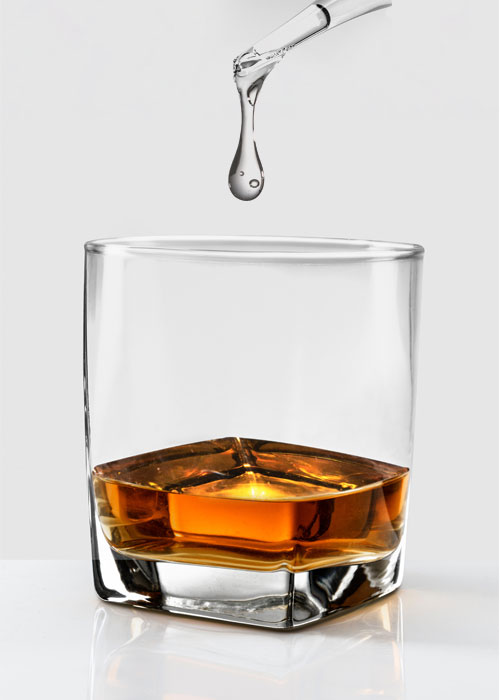The Great Whiskey and Water Debate

Ever found yourself staring at a beautiful pour, wondering if you should add a splash of water or a cube of ice? Maybe it’s come across a little hot for your palate? You’re not alone! This isn’t just a matter of personal taste (though that’s super important), it’s also a fascinating dance of molecules that can completely transform your whiskey experience. Let’s jump in and explore the magic that happens when water meets whiskey!
A Few Drops Can Unlock a World of Flavor
Imagine your whiskey as a bustling city, full of incredible aromas and flavors, but some are hidden behind tall buildings (the alcohol). When you add just a few drops of water, you’re essentially creating new pathways, allowing those hidden gems to come to the forefront.
Here’s the science-y bit, made simple:
Whiskey is mostly ethanol (alcohol) and water, but it’s also packed with tiny flavor molecules. Many of these flavor molecules are a bit “shy” and prefer to hang out with the ethanol. In a high-proof whiskey, these molecules can be trapped, and the strong alcohol can even numb your taste buds, making it harder to pick up on subtle notes.
When you add water, especially enough to bring the whiskey below about 45% alcohol by volume (ABV), something cool happens: the ethanol molecules move towards the surface of the liquid. This “pushes” those shy flavor compounds closer to the surface too. Once they’re at the surface, they can more easily evaporate into the air, reaching your nose and enhancing the aroma. It’s like opening a window and letting all those wonderful scents waft out!
Beyond aroma, water also:
Softens the “Alcohol Burn”: That fiery sensation you sometimes get? Water dilutes the ethanol, making the whiskey smoother and more approachable.
Reveals Hidden Notes: With the alcohol’s intensity toned down, flavors like vanilla, caramel, fruit, and spice can truly shine through.
Changes the Mouthfeel: A small splash of water can even make your whiskey feel “creamier” and more “luxurious” on your palate, enhancing its texture.
The Sweet Spot: Research suggests that an ideal ratio is around 80% whiskey to 20% water for maximizing flavor. But remember, this is a guideline, not a rule! And always use good quality, low-mineral water like distilled or certain spring waters to avoid introducing unwanted flavors. After all, after distillation every distillery proofs down their whiskey unless it is a straight from the barrel expression. Every Master Distiller has a proof they feel maximizes the flavor of each of their recipes. And they do this by adding quality water to lower the proof to the desired ABV.
Now, let’s talk about ice. Adding ice is a popular choice, especially on a warm day, but it brings its own set of changes to your dram.
Temperature vs. Flavor: The most immediate effect of ice is cooling the whiskey. While refreshing, this drop in temperature can make some of those delicate aroma compounds less volatile, essentially “muting” them. It’s like turning down the volume on your favorite song. Cold temperatures can also make your taste buds a bit less sensitive.
Dilution, But Slower: As ice melts, it gradually dilutes the whiskey, similar to adding water directly. This slow dilution can lead to an “evolving journey of flavors” as the whiskey changes over time in your glass. Size does matter. If you do opt for ice, go for large, single cubes or spheres. Why? They melt much slower than smaller cubes or crushed ice, giving you more control over the dilution and keeping your drink chilled without watering it down too quickly. Crushed ice, with its large surface area, melts rapidly and can quickly over-dilute your whiskey.
When Ice Shines:
High-Proof Whiskies: For cask-strength whiskies (60% ABV or higher), ice can help tame the alcohol’s intensity, allowing other flavors to emerge.
Refreshment: On a hot day, a chilled whiskey can be incredibly satisfying.
Some purists avoid ice for formal tastings or when trying a new whiskey for the first time, as it can mask subtle notes. If you want the chill without any dilution, whiskey stones are an option, though they won’t offer the gradual flavor evolution that melting ice does. Personally, I avoid whiskey stones. Too much thought with every sip, making sure you don’t chip a tooth.
Your Whiskey, Your Rules!
Ultimately, the best way to enjoy your whiskey is the way you like it. Here’s a simple approach to finding your perfect pour:
Taste it Neat First: Always try a new whiskey without any additions to understand its original character.
Experiment with Drops: If it feels too strong or you want to explore more flavors, add a few drops of water at a time. Swirl, sniff, and sip, noticing how the aromas and tastes evolve. I suggest just 2-3 drops.
Consider Ice: If you prefer it chilled or are drinking a high-proof spirit, try a large ice cube and see how the experience changes as it slowly melts.
Different whiskies often respond differently to water:
Cask-Strength: Almost always benefits from a little water to mellow its intensity.
Peated Whiskies: A few drops can enhance their smokiness without overwhelming.
Bourbon: Water can bring out those lovely caramel and vanilla notes.
So, the next time you choose a pour, be aware there is some fascinating science at play. Whether you choose a few drops of water, a slow melting ice cube, or nothing at all, you’re actively engaging with the spirit’s character. Try it several ways. You’ll find what works for you.

Leave a Reply
Become an insider and receive weekly advice, tips, and insight on all things whiskey
.
Weekly tips, reviews and recommendations to help you enjoy whiskey life to the fullest.
JOIN THE LIST
Sippin' With Jordan Davis
sippin' with the stars
Million Dollar Cowboy Bar WY
old fashioned aF
5 Steps To Sip and Savor Whiskey
whiskey 101
COMMENTS